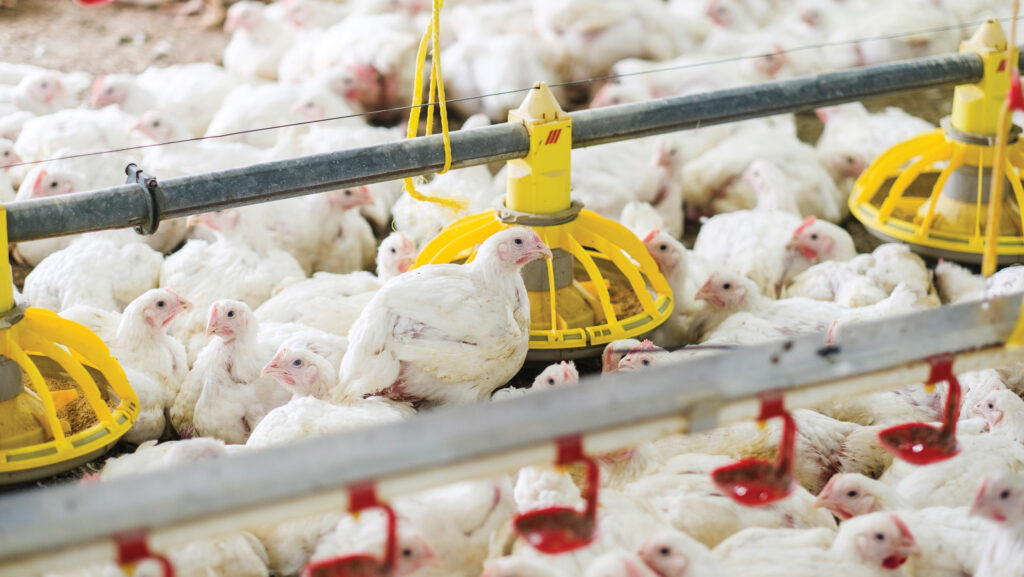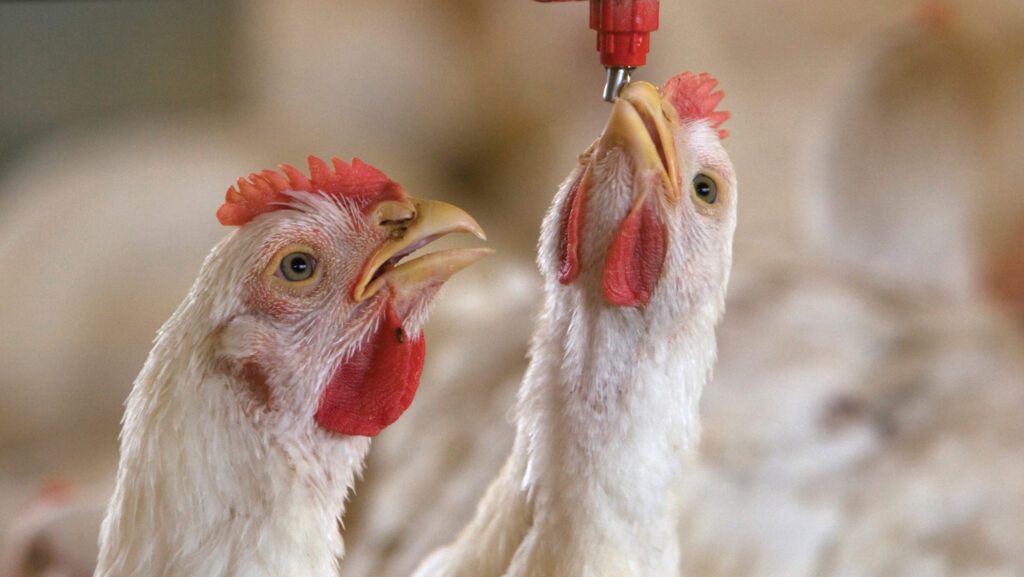4 ways to achieve a low feed conversion ratio in broilers
 © Joe Somerville
© Joe Somerville Effective hygiene is the first step to ensure broilers convert their feed efficiently into weight gain. Without this, it is likely to be an uphill struggle to maintain their health, and poor health will hit the feed conversion ratio – and profit margins.
The foundations of broiler health start with a thorough clean and disinfection. Independent broiler consultant Chris Durrant says care and attention need to go into evaluating the quality of terminal hygiene (see “Checking the efficacy of terminal hygiene”).
See also: A guide on how to improve water quality on poultry units
Once the farm is cleaned and disinfected, it is imperative that all necessary precautions are taken to prevent pathogens re-entering.
“Strictly adhering to a comprehensive set of biosecurity measures will protect the health status of the birds,” he says.
Producers can then focus on other areas of management that will influence the feed conversion ratio (FCR).
1. Brooding management
A broiler’s performance is directly linked to its gut health, says Chris.
“People don’t always associate brooding with FCR, but early compromises in feed and water intake invariably have a significant impact on nutrient utilisation later in the grow-out stage.”
The correct brooding conditions will encourage the gut to develop in size and capacity, leaving a larger surface area for digesting and absorbing feed later in the crop.
He says the initial development of the chick’s gut, over the first 12 hours on farm, is critical in underpinning the health of the gut for the rest of the bird’s life.
He recommends having a clear brooding strategy, which must include adequate feed and water provision and correctly preheated houses with consistent air and floor temperatures.
Closely monitoring the progress of the chicks through crop fills will give an indication of whether feed and water intakes are being maximised.
In addition, lighting should be bright enough to encourage activity while minimising stress levels.
Correct brooding conditions will result in the chicks quickly spreading across the house following placement.
2. Environmental management
Modern broiler house software allows for precise control of air exchange rates and environmental temperatures.
However, Chris suggests there is a fine balance to manage, adding that litter quality remains the key to maintaining a good environment and low FCRs.
“Thermal comfort has to be optimal,” he says. “This will be influenced by ventilation rates, the temperature profile and the heat generated by the litter.
“The aim is to provide the bird with an ideal temperature for growth and feed conversion, the so-called ‘thermoneutral’ zone.”
If birds are too hot, they will expend energy through panting and appetite will be lessened. If they are too cold, this will encourage huddling, and energy will be used to stay warm.
Dry, friable litter will generate a degree of warmth and makes it easier to keep birds comfortable.
Wet litter, brought about either by mismanagement of ventilation or gut health problems, leaves birds in contact with a colder surface, which will discourage feeding activity.
3. Management at times of stress
Growing broilers is inevitably a bumpy road, says Chris.
Unavoidable challenges to gut health come through periods such as vaccination, feed changes, thinning, and the ever-present threat of coccidiosis at about three weeks of age.
“Success is defined by how the bird overcomes the disease,” he explains. “We all know that coccidiosis affects feed conversion.
“It can lead to dysbacteriosis and, in extreme cases, enteritis. How quickly the bird gets over this challenge will have a clear link to the FCR.”

© Adobe Stock
Chris says this is where the other parts of the equation come into play: litter quality and temperature, the effects of over- or under-ventilating, high humidity, and the previous development of the gut will all affect the resilience of the bird at these times of stress.
“There will be a number of what I call ‘management insults’ throughout the crop. We all make mistakes; we’re all human,” he adds.
“The business of growing broilers is highly technical: we’re juggling huge amounts of air and trying to hold quite specific temperatures.
“The more robust the broiler and its gut health, the better it will deal with these.”
Chris warns that if the stresses are cumulatively mismanaged, they can become a tipping point for the bird, and health and feed conversion may start to suffer on a prolonged basis.
4. Management for maximum growth
Good growth rates are closely linked to good FCRs.
While FCRs are often only assessed at the end of a crop once final weights and feed amounts are known, growth rates are monitored closely throughout the broiler’s life.
These give a strong indication of how the birds are converting feed.
Working hard to maximise growth rates will also pay dividends in improving FCR.
“The broiler is appetite-driven and is sensitive to the size of particles in front of it,” says Chris.
“Feed it, in line with its appetite, with good-quality pellets, which will drive the performance, both in terms of growth rates and feed conversion.”
He adds that any pan systems that are not working correctly, or feed spills on the floor, will also have a negative impact on the bird achieving its potential.
How much attention should farmers pay to feed quality?
While pellet quality is critical in achieving a good feed conversion ratio (FCR), Chris Durrant suggests it is important to benchmark against other farms with the same inputs.
This is particularly the case when supplying as part of an integration, where feed and chick supply are closely managed by the processor.
Within an integration, margin calculations are stacked in favour of a good FCR, because incentives to reduce feed costs for the wider business are substantial.
Chris stresses that farm managers should feed each ration in accordance with the allocations given on the feed programme.
“The individual diets are carefully formulated to give the most efficient growth and development for the age of the bird,” he says. These naturally align weight gain with a low FCR.
Checking the efficacy of terminal hygiene
The traditional method of total-viable-count swabbing to estimate the concentration of micro-organisms can be limited in its scope, Chris Durrant warns.
An alternative is for farms to assess their on-farm disease burden with their vet by utilising a VIR check.
This comprises a series of polymerase chain reaction tests that can be used to determine the loadings of five common enteritic viruses found on farms.
A laboratory quantifies the levels of these viruses, then aggregates the score to provide a traffic-light assessment of the background viral challenge on the farm.
Chris says this can provide an important indicator of the efficacy of terminal hygiene.
“By monitoring and managing your disinfection more closely, you will reduce your viral loading,” he says.
“You’ve spent a lot of money on your cleaning and your chemicals – you need to check how that has gone. Viral challenges will affect the feed conversion ratio.”
